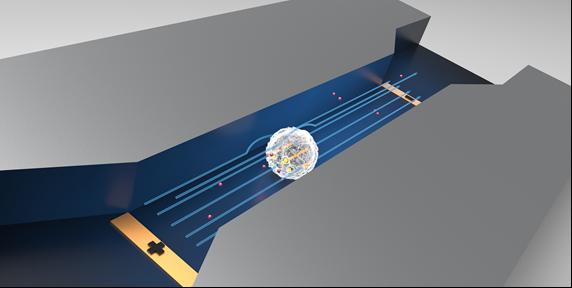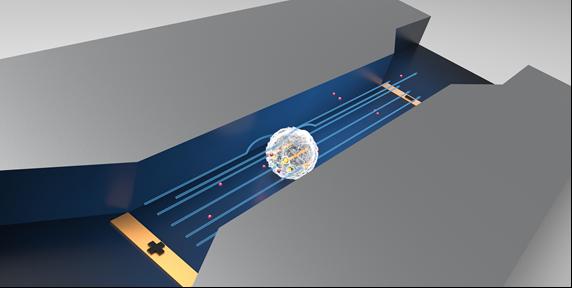
Credit: Technology Journal
Graduate students Mingde 'Jack' Zheng and Joseph Sherba have developed a novel, microfluidic platform for monitoring electroporation and molecular delivery at the single cell-level as part of a collaborative re-search team led by Professors Jeffrey Zahn and David Shreiber in the Department of Biomedical Engineer-ing and Professors Hao Lin and Jerry Shan in the Department of Mechanical and Aerospace Engineering at Rutgers, The State University of New Jersey, in Piscataway, NJ. Electroporation is a widely used, safe, non-viral approach to deliver foreign vectors into many different cell types. When a cell is exposed to an electric field of the appropriate strength, the membrane undergoes reversible electrical breakdown, where tran-sient pores form in the membrane, which allows molecular transport into the cell. The controlled intracellu-lar delivery of biomolecules and therapeutics enables the ability to study and engineer fundamental cellu-lar processes and has therefore been a major focus in biomedical research and clinical medicine. According to BioMarket Trends, the electroporation market currently represents the second largest segment of the total, ~$200 million transfection technology market in terms of revenues, behind lipid based technology.
Consumers in the market include those in biomedical research in academic and industry labs and biotech-nology and life science companies who aim to express specific molecules in a variety of cells. In addition, there is increased interest in using transfection technology clinically, especially with the advent of CRISPR technology for gene editing.
Successful cell transfection represents the rate-limiting step in numerous biomedical research and bioproduction workflows including: cell based therapies, RNA interference screening, and stem cell re-search. The challenges include variable and poor transformation efficiency, especially with hard-to-transfect cell lines such as primary cell lines and stem cell lines. One of the traditional bottlenecks to elec-troporation has been obtaining efficient delivery without compromising cell viability. Successful electro-poration involves the optimization of a wide range of electric field and buffer parameters that are affected by the cell type and molecular payload to achieve an ideal balance of the efficiency of transfection (how much is delivered) with the damage produced (how many cells are damaged or die). Protocols are often identified through costly trial-and-error, and can vary significantly from lab-to-lab and application-to-application. The Rutgers interdisciplinary research and development team are focusing on translational re-search in developing next-generation electroporation technology for high-efficiency delivery into cells with superior viability.
The novelty of this report is the impedance detection of membrane permeabilization in a continu-ous flow environment at unprecedented sensitivity, an accomplishment not previously reported in litera-ture. By monitoring changes in the electrical characteristics of individual cells when exposed to short, high-strength electric fields, the team was able to identify when a cell has become permeabilized and deter-mine the conditions which led to molecular delivery while preserving cell viability. This technology will ex-pedite the transfection process by eliminating trial-and-error electroporation protocol development in a safe and effective manner across cell types and applications.
The micro-electroporation platform was realized following extensive theoretical modeling. The team de-signed and fabricated a microfluidic device consisting of a converging microfluidic 'electroporation zone' and a set of electrodes capable of both pulsing the passing cell in transit and sensing the degree of cell membrane permeabilization. The electroporation microchip is integrated with a custom-built LabVIEW al-gorithm that continuously monitors the channel for the entrance of a cell into the electroporation zone. Upon detecting a cell, a prescribed electrical pulse is applied to the cell and the electrical signal is monitored for changes in membrane permeabilization, which ultimately determines the therapeutic payload poten-tial.
A widespread parametric study was performed by altering both the electric field strength and pulse duration and electrically measuring the membrane impedance response immediately following pulse application. The degree of membrane permeabilization was dependent on the intensity of the pulse appli-cation, with a significant increase in permeabilization occurring at a pulse duration of 0.8 to 1 ms. This trend was also verified by optically monitoring the delivery of a fluorescent probe, propidium iodide, which is im-permeant to cells with intact membranes but is transported into the cell upon compromising the mem-brane via electroporation. Cell viability trends were also shown to be dependent on the strength and dura-tion of the pulse being applied.
Moving forward, the Rutgers team looks to continue the development of this technology into a "smart", autonomous system that is capable of using these electrical signals to create a flow-through, feedback-controlled, single cell-level electroporation platform. Improvements in transfection efficiency will allow electroporation-based cellular transformation approaches to become more commonplace and supplant viral based approaches. They envision a product line comprised of a base equipment docking sta-tion and software that applies the electric pulses and monitors permeabilization in real time using disposa-ble "chips" for cell handling and microfluidics. The end result will be a product line that is easy to use, re-producible, and robust, which will open up a wide range of applications by basic research laboratories, de-velopment and production laboratories in the biotechnology sector, and ultimately clinical entities inter-ested in direct gene editing or transfection for transplantation and cellular therapies.
###
Corresponding author for this study in TECHNOLOGY is Professor Jeffrey Zahn, Ph.D., [email protected].
Media Contact
Chin Wanying
[email protected]
65-646-65775
@worldscientific
http://www.worldscientific.com
############
Story Source: Materials provided by Scienmag





